|
|
|
|
|
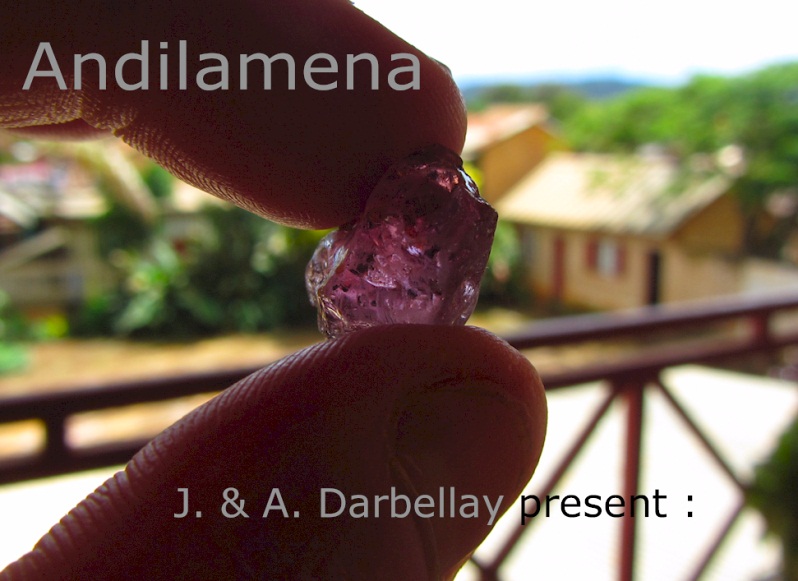 |
|
|
|
|
|
|
NEW SAPPHIRE MINE IN ANDILAMENA, MADAGASCAR |
|
|
|
|
|
|
|
News from the front ... |
|
|
|
|
|
The regular and intermittent drizzle that had fallen on the region suddenly died |
|
|
down. It had sprinkled the area for seven days. A lean period, you might think, |
|
|
however that definitely wasn’t the case since sapphires and rubies never ceased |
|
|
to flock towards John. |
|
|
|
|
|
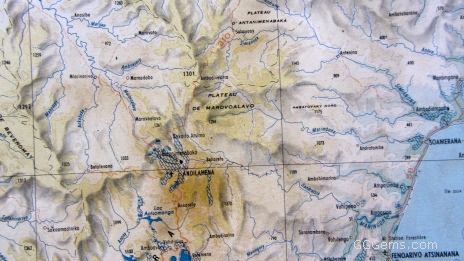 |
|
|
|
|
|
Ah! The rainy season… |
|
|
|
|
|
|
|
|
|
Hostilities had begun in the highlands when John went to Mahaiza, the |
|
Mecca of highwaymen, which abound in these regions. Also the Mecca of |
|
aquamarines, of rubellites and of every pegmatitic rock surrounding the |
|
Antsirabe area. |
|
|
|
The first picture here attached, is a testimony of roads transformed into |
|
a real “Via Crucis”. |
|
| Meanwhile, Alain continued with his program. |
|
| Since the colony, Madagascar was known as Beryl Country. Today times have |
| changed and we readily describe the Red Island as Corundum Country. Red and Blue |
| are thus combined in a prose à la Stendhal turned daltonic. For the better and the |
| worse, Rubies and Sapphires reveal their velvetiness and their hardness. |
|
| In an era that hasn’t rung yet, we will qualify Madagascar the country of pure carbon. |
| The diamond, one hundred and twenty times harder than its sibling the sapphire, is |
| still lurking beneath the sandstones or in dykes under unsuspected depths. |
|
|
|
|
|
|
When it was rumoured that a new alluvial mine of sapphires and rubies had been |
|
revealed, John changed his course. |
|
By a coincidence that only nature knows the secret, the discovery happened the |
|
day of our arrival on the island. |
|
But here, we enter into a fourth dimension in space and time, time that was |
|
needed for our adventurer to reach his spot. Twenty five hours of a wet track |
|
winding the border of the east coast’s rainforests. |
|
|
|
|
|
|
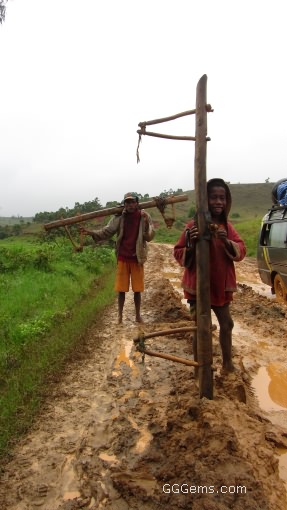 |
|
|
|
|
|
|
|
|
|
|
|
|
|
|
|
|
|
On the shoulders of this man, a yoke, used for |
|
harnessing his oxen. |
|
|
|
A zebu is one of the symbols of Madagascar. |
|
In the past, on the Red Island, they were |
|
more numerous than men. |
|
|
|
|
|
|
|
|
|
|
|
|
|
|
|
|
|
|
|
|
|
|
|
|
|
|
|
|
|
The last village leading to the Holy Grail left John with 18 hours walking distance |
|
from the alluvial deposit. |
|
|
|
|
|
|
|
|
|
|
|
Middleman showing a |
|
pink sapphire into his |
|
sharp fingers. It comes |
|
from a place said |
|
Sahalava, 30 kilometers |
|
north of Andilamena. |
|
This new deposit was |
|
discovered in November |
|
2013. |
|
|
|
|
|
| For the corundums revealed a parade of heteroclitical |
| colours, passing from royal blue to soft pastels and then |
| to pinks, purples, yellows and every colour of the rainbow |
| that leads to the pot of gold. |
| This gold John didn’t have in his pockets yet, but, it was |
| then that the difficulties had just begun. |
|
|
|
|
|
|
Andilamena, it is at this place, in October 2000, where an important |
|
ruby deposit was discovered. It caused a rush that definitely |
|
transformed this big rural village lost in the middle of nowhere. |
|
|
|
The relations that John tied with gemstone miners and sellers present |
|
at the time of the rush in 2001, thanks to his mastery of the Malagasy |
|
language, permitted him to glean a lot of information. |
|
|
|
These discoveries, distanced a several dozen kilometres from the |
|
village, have unearthed hundreds of kilos of rubies inside some veins |
|
of feldspar turned endomorphic which disaggregated into the form of |
|
kaolin. |
|
At the time, miners dug up to eight meters in depth inside the veins |
|
which were then followed by many mica minerals. Some pockets, in the |
|
shape of lentils, produced up to two hundred kilos of gems which were |
|
quickly acquired by Thais who had flocked to the region. Sometimes |
|
purchased as a star ruby, i.e. cabochon quality, these rubies of |
|
remarkable colour and dimensions would, according to the Malagasy |
|
who were present, have enriched their buyers. |
|
|
|
In 2002, a new sapphire deposit was discovered at a place called |
|
Andribabe. |
|
It’s in 2004 when Alain was able to observe remarkable samples of |
|
royal blue sapphires from Andribabe. |
|
|
|
|
|
| |
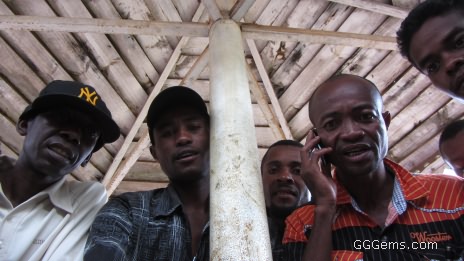 |
| On the spot, John found many |
| friends and acquaintances |
| forged throughout previous |
| decades. Some on a sapphire |
| deposit in the North in 1996, |
| some in the Ilakaka, deposit, |
| in 1999-2000, etc. |
|
|
|
|
|
|
|
|
To get to the deposit, there is only one solution: the motorcycle. |
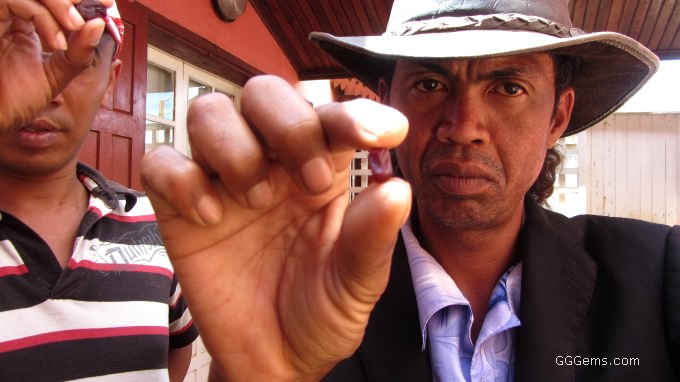 |
|
|
|
Once again, John applied his technique: he paid |
|
|
a disproportionate price for the first stone that |
|
|
fell into his hands thus attracting all the others |
|
towards him. This provoked a wrath in some |
|
Asian competitors who had rushed to the |
|
place of the discovery. |
|
|
|
|
|
|
|
|
|
|
|
|
|
|
|
|
|
|
|
Vehicles suffer when |
|
reaching Andilamena in |
|
this season. This modest |
|
garage offers a welcome |
|
service, thanks to this old |
|
man. A remake of Charlie |
|
Chaplin’s Modern Times. |
|
|
|
|
|
|
|
|
|
|
|
|
|
|
|
|
|
Karazam'bato (sapphires of lower quality) are sold here in bulks like piles of gravel. |
|
|
|
|
|
|
|
|
|
John in front of his room, accompanied by the charming and friendly owner of the |
|
|
Magic Hotel. |
|
|
|
|
Aerial view of Andilamena. |
|
| Alaotra formations: |
|
|
|
|
|
| Crystalline schists: |
|
| The petrographic bottom is characterized by an |
|
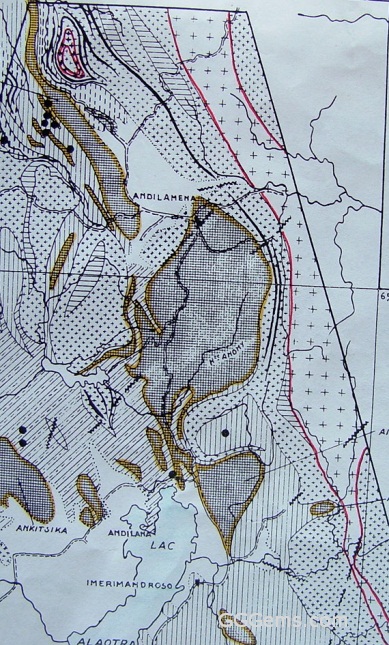 |
| abundance of pyroxeno-amphibolic formations in a set in |
|
| which gneissico-migmatitic rocks are found as follows: |
|
| - The gneisses at hypersthene are well represented on |
|
| the North and East bank of Lake Alaotra: |
|
| - Amphibolites and shale feldspathics pyroxenites |
|
| appearing frequently in patches or enclaves to form |
|
| heterogeneous migmatites of épibolites type (rocks |
|
| consist of interbedded veins of aplites beds per bed). |
|
| - The amphibole gneiss, amphibole and biotite, or biotite |
|
| alone can pass locally to banded migmatites. |
|
| - Locally surmicaceous gneiss and mica becoming |
|
| micaschists and containing shreds of muscovite mica |
|
| schists between the rivers Onibe and Ivondro. |
|
| - Finally, beds of quartzite or magnetite quartzite |
|
| distributed of very irregular manner : magnetite quartzites |
|
| show a bigger development in the region of |
|
| Imerimandroso and Andilamena peninsula, on the shores of |
|
| Lake Alaotra; white quartzites more or less crystallized are |
|
| quite rare and form thin beds. |
|
| We can distinguish an aluminous series and |
|
| calco-magnesian series. Alumino-silicate series is not |
|
| uniformly distributed, but appears quite clearly located at |
|
| the base of the group of Alaotra. This series is represented |
|
| by sillimanite quartzites and gneisses more or less quartzic |
|
| biotite, sillimanite and garnet, very often these gneiss are |
|
| graphitic. |
|
| Calc-magnesian series develops on the western bank of |
|
| the group Alaotra, especially south of Ambatondrazaka |
|
| where diopside gneisses and marbles are of great |
|
| importance. |
|
|
| - Gabros have a significant development in the group Alaotra, their main feature is their perfect match with |
| the surrounding formations. |
|
Rubies from this region have been found in alluvium,
|
 |
 |
|
but probably come from endomorpheous feldspatic
|
|
rocks. In fact, we frequently found corundums showing
|
| flat faces in feldspatic rocks in Madagascar. |
|
|
| GEOLOGICAL SURVEY OF THE ANDILAMENA NORTHERN REGION |
|
| The North- Andilamena area aload to establish a geological connection between the Lake Alaotra |
| region and the Mandritsara region. Five petrographic units were distinguished. At the base we find a |
| graphitic series with sillimanite and garnet with many leptynites banks in the south, it has been found |
| on the eastern edge of the studied area only. Above it, there are biotite migmatites with small |
| hornblende passages : they flush heavily on the Maroadabo sheet, and reappear in anticlinal position |
| throughout the western limit of the studied area. |
| They are locally overlain by a small graphitic series with marbles, gneisses at pyroxene and wernérites. |
| Epibolites and amphibolitic gneisses form the foothills of the Bemarivo. |
| Finally, in the Tanananifololahy region, pyroxeno-amphibolites are associated with more or less metamorphic |
| gabbros. The three bottom sets ( graphitic basic series, biotite migmatites, graphitic series at cipolin of |
| Marovato) are attached to the System of Graphite; épibolites and hornblende gneisses as well as pyroxeno |
| - amphibolites are considered belonging to the Vohibory System. |
|
| The area covered by the sheet is formed essentially by gneissic-migmatitic rocks, bit affected by |
| granitisation in the central zone and including on the contrary many granite benches interbedded on |
| the eastern and western borders. |
|
|
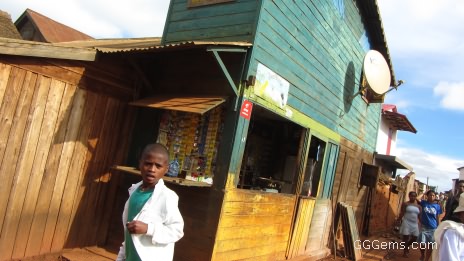 |
|
|
|
|
|
| In Andilamena, any |
|
| grocery store can be |
|
| equipped with a |
|
| satellite dish. |
|
|
|
|
|
|
|
|
|
|
|
|
|
|
|
| Days passed and a sound, or rather, an intoxicating melody, came to the ears of our |
|
| protagonists: a new deposit of sapphires of an exceptional blue colour was brought |
|
| to light in the Didy area (which I mentioned in my previous article). |
|
| Then, simultaneously, a discovery of pigeon blood rubies was announced at 4 miles |
|
| from the sea border, on the east coast... Everyone broke camp. |
|
|
|
| It is thus how gem research is conducted in Madagascar today, a country that has |
|
| become the leading producer of sapphires and rubies in the world. |
|
|
|
| At the time when the mobile phone was still in its infancy, it took more than two |
|
| years before the discovery of an exceptional sapphire, which I and John made in |
|
| south-eastern Madagascar, had been disclosed. |
|
|
|
| It was Andranondambo. The quality of this sapphire remained a model in the |
|
| gemmology field. |
|
| Today, this sapphire is compared to those of Kashmir. |
|
| It is in fact during the occasion of our presence on the island, late 2013-2014, that |
| we also learned about the discovery of a new sapphire deposit in the Andranondambo |
| region. |
|
|
|
|
By clicking on the following link you can read an article written by Alain on what |
|
|
certainly remains the discovery of the century in sapphire and ruby history: |
|
|
|
|
|
http://www.gggems.com/news_didy_sapphire_ruby_discovery.htm |
|
|
|
|
|
Unearthed in 2012, in Madagascar, this deposit, discovered in the heart of the |
|
|
rainforest, has produced the largest pigeon blood rubies in the world. The icing |
|
|
on the cake? They do not require any treatment. Exactly the same goes for all |
|
|
exceptionally coloured sapphires that have escaped the place, a natural reserve |
|
|
rapidly sealed off by the authorities. |
|
|
|
 |
Corundums / Visual Catalog / Safari |
 |
| Geological references: A. Lenoble, P. Brenon, J. Aurouze, J. Guignes, L. Laplaine, |
|
| |
Your guide to GGGems |
| R. Lautel, H. de la Roche, M. Bertucat, L. Delbos, O. Dottin, R. Girardon, G. Noizet, |
A. Darbellay |
| M. Rantoanina. |
|
|
|
|
|
images by J. Darbellay |
|
|
An article of : |
|
 |
|
 |
 |
 |
|







